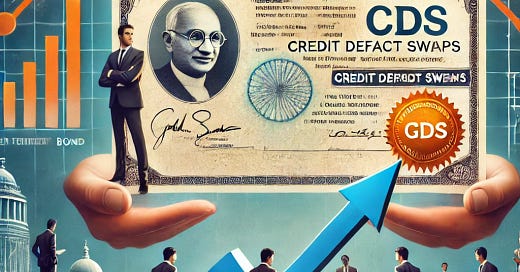Credit Default Swaps (CDS) and Country Risk: Who Really Pays When a Country Defaults?
Hi readers,
Welcome to the latest edition of the weekly newsletter.
I hope you are fine with your family
Suppose,
What happens when a country can’t pay back its debt? Who takes the loss—the country, the investors, or someone else?
In global finance, Credit Default Swaps (CDS) play a crucial role in managing country risk. Investors often use CDS as insurance against the risk of a government defaulting. But does this mean a country can escape its debt obligations without consequences?
Let’s break it down step by step.
What Is a Credit Default Swap (CDS)?
A CDS is like insurance for investors who buy government bonds. When an investor lends money to a country by purchasing bonds, they risk losing money if the country fails to repay. To protect themselves, investors buy CDS from financial institutions (like Goldman Sachs or JPMorgan), paying a small annual fee (CDS spread) in exchange for protection.
If the country never defaults, the CDS seller keeps the premium and makes a profit. But if the country does default, the CDS seller must compensate the investor for their losses.
How Does CDS Work in a Default?
Let’s assume an investor buys $1 million in Indian government bonds but is worried about default risk. They buy a CDS contract from Goldman Sachs, paying a 1.5% annual premium ($15,000 per year) for protection.
Now, suppose India defaults and can only repay 40% of its debt. Here’s what happens:
1️⃣ India pays $400,000 to the investor (40% recovery).
2️⃣ The CDS contract activates, and Goldman Sachs must cover the remaining 60% ($600,000).
3️⃣ Goldman Sachs does not collect this money from India—they take the loss but are prepared for it.
This means the investor still gets their full $1 million—some from India, some from Goldman Sachs.
Who Really Pays for the Default?
It may seem like India benefits by only paying 40% instead of 100%, but defaulting has serious long-term consequences:
🔹 Credit Rating Drop – Rating agencies like Moody’s and S&P downgrade India’s credit rating, making future borrowing much more expensive.
🔹 Foreign Investors Leave – Investors demand higher interest rates or stop lending to India altogether.
🔹 Currency Depreciation – The rupee weakens, increasing inflation and making imports more expensive.
🔹 Stock Market Impact – Companies struggle to raise funds, causing stock prices to fall.
A great example is Argentina, which has defaulted multiple times. Even today, investors charge very high interest rates to lend to Argentina because trust has been damaged.
Why Does the CDS Seller (Goldman Sachs) Pay If India Defaults?
Since Goldman Sachs only collected 1.5% per year in CDS premiums, why would they suddenly pay 60% of the bond value ($600,000)?
Here’s why:
1️⃣ Most countries don’t default – Goldman Sachs sells CDS in many countries, and in most cases, they keep the premiums without ever having to pay.
2️⃣ Risk Hedging – Banks use derivatives and bond trading to reduce their exposure.
3️⃣ Careful Pricing – Higher-risk countries pay higher CDS spreads to balance risk and reward.
Goldman Sachs is betting that India won’t default. But if it does, they are prepared to take the loss and move on—this is the risk they accepted when they sold the CDS.
Two Ways to Estimate India’s Country Risk
Investors use two common methods to estimate India’s risk-free rate by adjusting for country risk:
1️⃣ Simple CDS Subtraction Method (Less Accurate)
📌 Risk-Free Rate = 10Y Bond Yield – CDS Spread
📌 Example: 6.74% (India 10Y Bond) – 1.5% (CDS) = 5.24% is the pure 10Y bond yield
🔹 Problem? This assumes a 100% loss in a default, which is unrealistic since investors typically recover some money.
2️⃣ CDS Adjusted for Recovery Rate (More Accurate)
📌 Risk-Free Rate = 10Y Bond Yield – (CDS × (1 - Recovery Rate))
📌 Example: 6.74% – (1.5% × 60%) = 6.74% – 0.9% = 5.84%
🔹 Why is this better? It adjusts for the fact that India still pays back 40% in default.
🔹 This is the method used by professional investors and valuation experts.
Final Takeaways
✔ CDS is an insurance contract—it protects investors, but it does not protect countries from default consequences.
✔ If India defaults, investors get paid from CDS sellers (like Goldman Sachs), not from India.
✔ Defaulting helps India short-term but hurts it long-term—higher borrowing costs, investor flight, weaker currency, and slower economic growth.
✔ Estimating risk-free rates? Adjusting CDS for the recovery rate is the more accurate method.
CDS is a powerful tool in finance, but it’s not a free pass for governments. Countries must manage their economies carefully to maintain trust in global markets.
What do you think? Should investors trust CDS as a perfect hedge, or are there deeper risks involved?
I would love to know your thoughts on it
Growth Inshots




